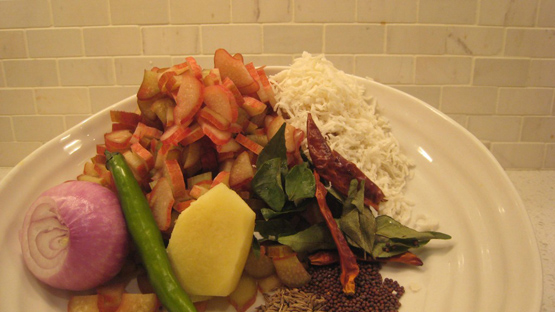
This pachadi is a gorgeously light pink. The photo taken at night under poor lightly doesn’t do it justice in looks and flavour.
On my days off I often like to try out new recipes at home. When successful I like to share the results with colleagues in my work kitchen. One of them is a vegetarian. She is also the most patient and most receptive in listening about my home culinary exploits. The other day I went to work eager to share with her my recipe for Rhubarb Pachadi. I explained to her that a pachadi, a South Indian version of raita, is a side dish where a singular vegetable or fruit is briefly cooked, in some cases raw, and added to spiced yogurt. In India it is considered to be a ‘salad’ where the yogurt is used as a dressing. However, I told her that it may be easier to think of it as a sauce and served with meals to contrast hot and spicy dishes. A pachadi is great with rice and vegetables or for non vegetarians with pork, duck, chicken or even fish like halibut or pickerel. Upon finishing my description of the recipe she told me how delish it sounded but that “you need to know you had me at rhubarb”.
- 2 cups thinly sliced red rhubarb (do not peel)
- 1 tbsp ginger, finely chopped
- 1 green cayenne chile finely chopped
- ¼ cup water
- ¼ cup coconut, grated fresh or frozen
- Tempering
- 2tbsp vegetable or coconut oil
- 1 tsp black mustard seeds
- 2 shallots, thinly sliced
- 20 curry leaves
- ½ tsp cumin seeds
- 1 cup plain yogurt
- Heat a medium sized pan over medium high heat. Add rhubarb, ginger, chile and water. Cover and reduce heat to medium. Cook for 10 minutes occasionally stirring and mashing with back of spoon. Add yogurt and coconut. Cook for 2-3 minutes then remove from heat and place in serving bowl.
- In a small frying pan heat the oil over medium high heat. Add mustard seeds and when they start to sputter add remaining ingredients. Stir fry for 3-5 minutes or until shallots are lightly golden brown. Spoon cooked onions and spices over yogurt. Serve at room temperature.
- The rhubarb pachadi can be stored, covered, in fridge for a few days. Bring back to room temperature before serving.


